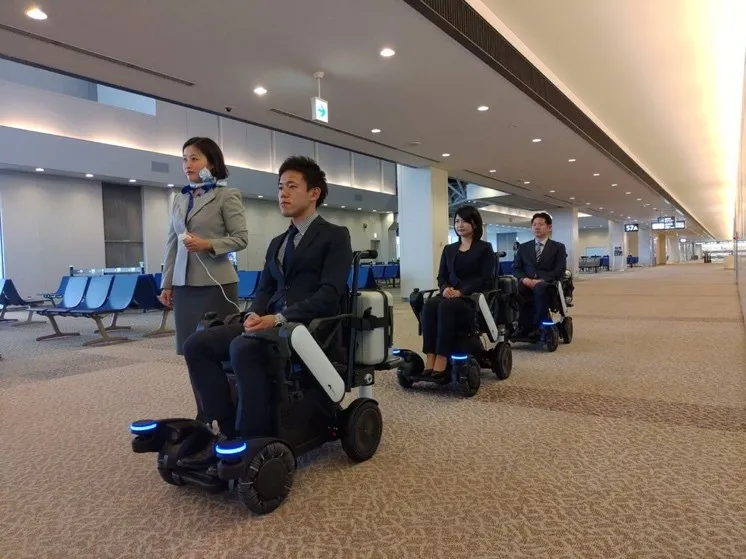
Narita's self-driving wheelchairs aim to help disabled
May 16, 2019

Narita has developed innovative self-driving wheelchairs designed to enhance mobility for individuals with disabilities. These advanced wheelchairs utilize cutting-edge technology, including sensors and artificial intelligence, to navigate autonomously in various environments. Users can easily direct the wheelchair through simple voice commands or mobile applications, promoting independence and reducing the need for assistance. The system is equipped with safety features that prevent collisions and ensure a smooth ride. By merging accessibility with modern technology, Narita aims to improve the quality of life for those with mobility challenges, offering them greater freedom and the ability to explore their surroundings with confidence.
Overview of Narita's Self-Driving Wheelchairs
Narita's innovative self-driving wheelchairs are poised to revolutionize mobility for individuals with disabilities. These advanced wheelchairs are designed to enhance independence and improve the quality of life for users. By integrating cutting-edge technology, Narita aims to create a seamless experience for those who rely on wheelchairs for mobility.
Key Features of Self-Driving Wheelchairs
The self-driving wheelchairs from Narita come equipped with a variety of features aimed at enhancing user experience. Below is a table summarizing the key features:
| Feature | Description |
|---|---|
| Autonomous Navigation | Utilizes advanced sensors and AI algorithms to navigate through various environments. |
| Obstacle Detection | Equipped with sensors that identify and avoid obstacles in real-time. |
| User-Friendly Interface | Easy-to-use controls that allow users to set destinations and adjust settings effortlessly. |
| Customizable Settings | Users can personalize their experience by adjusting speed, sensitivity, and other preferences. |
| Emergency Stop Feature | Ensures user safety by providing an immediate stop option in case of emergencies. |
Benefits of Using Narita's Self-Driving Wheelchairs
There are several significant benefits associated with the use of Narita's self-driving wheelchairs. These advantages not only empower users but also contribute to a more inclusive society.
- Increased Independence: Users can navigate public spaces without assistance, promoting autonomy.
- Enhanced Safety: The obstacle detection feature minimizes the risk of accidents, ensuring a safer experience.
- Improved Accessibility: Self-driving wheelchairs can access areas that may be challenging for traditional wheelchairs.
- Reduction in Caregiver Strain: With a self-driving option, caregivers can focus on other tasks, alleviating their workload.
- Social Inclusion: Users can participate in social activities without relying on others for mobility.
Technology Behind Self-Driving Wheelchairs
The technology behind Narita's self-driving wheelchairs is groundbreaking. At the core of this innovation are several key components:
- Artificial Intelligence: AI algorithms enable the wheelchair to learn from its environment, adapting to various terrains and situations.
- Advanced Sensors: These sensors collect data about the surroundings, allowing for real-time navigation adjustments.
- GPS Integration: GPS technology provides precise location tracking, helping users reach their desired destinations efficiently.
- Battery Management System: Ensures optimal power usage, extending the wheelchair's operational range.
Real-World Applications
Self-driving wheelchairs have a wide range of applications in various settings. Here are some examples:
| Setting | Application |
|---|---|
| Hospitals | Patients can navigate the hospital without assistance, reducing the need for staff support. |
| Shopping Malls | Users can explore shopping centers independently, enhancing their overall experience. |
| Parks and Recreation Areas | Self-driving wheelchairs can navigate uneven terrain, allowing users to enjoy outdoor activities. |
Challenges and Considerations
While Narita's self-driving wheelchairs offer numerous benefits, there are challenges that must be addressed:
- Cost: The price of advanced technology may limit accessibility for some users.
- Public Acceptance: Educating the public about self-driving wheelchairs is crucial for widespread adoption.
- Regulatory Hurdles: Navigating laws and regulations regarding autonomous vehicles can be complex.
The Future of Mobility for Disabled Individuals
As technology continues to evolve, the future looks promising for mobility solutions designed for disabled individuals. Narita's self-driving wheelchairs represent a significant step forward in this journey. With ongoing improvements and innovations, these wheelchairs could become an integral part of everyday life for many, fostering greater independence and inclusivity.
Conclusion
Narita's self-driving wheelchairs are not just a technological marvel; they symbolize hope and empowerment for individuals with disabilities. By focusing on user experience and safety, Narita is paving the way for a future where mobility is accessible to everyone. With continued advancements in technology, the vision of a more inclusive society is within reach.
Related Articles

Explore Thailand: The Best Islands to Visit for Paradise, Adventure, and Relaxation

The Ultimate Guide to the Best Islands in Thailand for Your Next Getaway

Do babies need passports? How to get a passport for a newborn

How to get a U.S. passport fast: here’s how to expedite the process

What is Mobile Passport Control: 5 reasons why you should use it

SENTRI vs. Global Entry: A detailed guide

Do you need a passport to go to the Bahamas? Let’s find out

Do you need a passport to go to Mexico? A detailed guide

Do you need a passport to go to Canada? We got the answer

Do You Need a Passport for a Cruise: An Essential Travel Guide

Booster Seat Requirements: All the Rules to Follow in Your Rental Car

What Are the World’s Most Powerful Passports, and How Does Yours Rank?

How to Take a Passport Photo at Home: A Helpful Guide

You've got to have heart! Southwest's new livery

Your opinion: Should water be free on low cost carriers?

Young women bolder than guys as solo travellers
